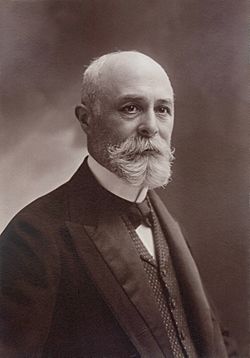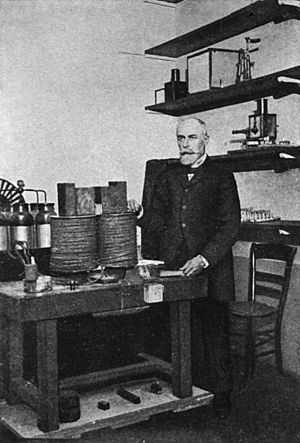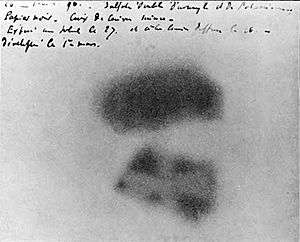Henri Becquerel facts for kids
Quick facts for kids
Henri Becquerel
|
|
|---|---|

Henri Becquerel c. 1905
|
|
| Born | 15 December 1852 Paris, France
|
| Died | 25 August 1908 (aged 55) Le Croisic, Brittany, France
|
| Alma mater | École Polytechnique École des Ponts et Chaussées |
| Known for | Discovery of radioactivity |
| Awards |
|
| Scientific career | |
| Fields | Physics, chemistry |
| Institutions | Conservatoire des Arts et Metiers École Polytechnique Muséum National d'Histoire Naturelle |
| Thesis | Recherches sur l'absorption de la lumière |
| Doctoral advisor | Charles Friedel |
| Doctoral students | Marie Skłodowska-Curie |
| Signature | |
| Notes | |
|
He is the father of Jean Becquerel, son of Edmond Becquerel, and grandson of Antoine César Becquerel
|
|
Antoine Henri Becquerel (/ˌbɛkəˈrɛl/; 15 December 1852 – 25 August 1908) was a French engineer, physicist, Nobel laureate, and the first person to discover evidence of radioactivity. For work in this field he, along with Marie Skłodowska-Curie and Pierre Curie, received the 1903 Nobel Prize in Physics. The SI unit for radioactivity, the becquerel (Bq), is named after him.
Biography
Early life
Becquerel was born in Paris, France, into a wealthy family which produced four generations of physicists: Becquerel's grandfather (Antoine César Becquerel), father (Alexandre-Edmond Becquerel), and son (Jean Becquerel). Henri started off his education by attending the Lycée Louis-le-Grand school, a prep school in Paris. He studied engineering at the École Polytechnique and the École des Ponts et Chaussées. In 1874, Henri married Lucie Zoé Marie Jamin, who would die while giving birth to their son, Jean. In 1890 he married Louise Désirée Lorieux.
Career
In Becquerel's early career, he became the third in his family to occupy the physics chair at the Muséum National d'Histoire Naturelle in 1892. Later on in 1894, Becquerel became chief engineer in the Department of Bridges and Highways before he started with his early experiments. Becquerel's earliest works centered on the subject of his doctoral thesis: the plane polarization of light, with the phenomenon of phosphorescence and absorption of light by crystals. Early in his career, Becquerel also studied the Earth's magnetic fields.
Becquerel's discovery of spontaneous radioactivity is a famous example of serendipity, of how chance favors the prepared mind. Becquerel had long been interested in phosphorescence, the emission of light of one color following a body's exposure to light of another color. In early 1896, there was a wave of excitement following Wilhelm Conrad Röntgen's discovery of X-rays on 5 January. During the experiment, Röntgen "found that the Crookes tubes he had been using to study cathode rays emitted a new kind of invisible ray that was capable of penetrating through black paper". Learning of Röntgen's discovery from earlier that year during a meeting of the French Academy of Sciences caused Becquerel to be interested, and soon "began looking for a connection between the phosphorescence he had already been investigating and the newly discovered x-rays" of Röntgen, and thought that phosphorescent materials, such as some uranium salts, might emit penetrating X-ray-like radiation when illuminated by bright sunlight.`
By May 1896, after other experiments involving non-phosphorescent uranium salts, he arrived at the correct explanation, namely that the penetrating radiation came from the uranium itself, without any need for excitation by an external energy source. There followed a period of intense research into radioactivity, including the determination that the element thorium is also radioactive and the discovery of additional radioactive elements polonium and radium by Marie Skłodowska-Curie and her husband Pierre Curie. The intensive research of radioactivity led to Becquerel publishing seven papers on the subject in 1896. Becquerel's other experiments allowed him to research more into radioactivity and figure out different aspects of the magnetic field when radiation is introduced into the magnetic field. "When different radioactive substances were put in the magnetic field, they deflected in different directions or not at all, showing that there were three classes of radioactivity: negative, positive, and electrically neutral."
As often happens in science, radioactivity came close to being discovered nearly four decades earlier in 1857, when Abel Niépce de Saint-Victor, who was investigating photography under Michel Eugène Chevreul, observed that uranium salts emitted radiation that could darken photographic emulsions. By 1861, Niepce de Saint-Victor realized that uranium salts produce "a radiation that is invisible to our eyes". Niepce de Saint-Victor knew Edmond Becquerel, Henri Becquerel's father. In 1868, Edmond Becquerel published a book, La lumière: ses causes et ses effets (Light: Its causes and its effects). On page 50 of volume 2, Edmond noted that Niepce de Saint-Victor had observed that some objects that had been exposed to sunlight could expose photographic plates even in the dark. Niepce further noted that on the one hand, the effect was diminished if an obstruction were placed between a photographic plate and the object that had been exposed to the sun, but " … d'un autre côté, l'augmentation d'effet quand la surface insolée est couverte de substances facilement altérables à la lumière, comme le nitrate d'urane … " ( ... on the other hand, the increase in the effect when the surface exposed to the sun is covered with substances that are easily altered by light, such as uranium nitrate ... ).
Experiments
But further experiments led him to doubt and then abandon this hypothesis.
Late career
Later in his life in 1900, Becquerel measured the properties of Beta Particles, and he realized that they had the same measurements as high speed electrons leaving the nucleus. In 1901 Becquerel made the discovery that radioactivity could be used for medicine. Henri made this discovery when he left a piece of radium in his vest pocket and noticed that he had been burnt by it. This discovery led to the development of radiotherapy which is now used to treat cancer. Becquerel did not survive much longer after his discovery of radioactivity and died on 25 August 1908, at the age of 55, in Le Croisic, France. His death was from unknown causes, but was reported that "he had developed serious burns on his skin, likely from the handling of radioactive materials."
Honors and awards
In 1889, Becquerel became a member of the Académie des Sciences. In 1900, Becquerel won the Rumford Medal for his discovery of the radioactivity of uranium and he was made an Officer of the Legion of Honour. The Berlin-Brandenburg Academy of Sciences and Humanities awarded him the Helmholtz Medal in 1901. In 1902, he was elected as a member of the American Philosophical Society. In 1903, Henri shared a Nobel Prize in Physics with Pierre Curie and Marie Curie for the discovery of spontaneous radioactivity. In 1905, he was awarded the Barnard Medal by the U.S. National Academy of Sciences. In 1906, Henri was elected Vice Chairman of the academy, and in 1908, the year of his death, Becquerel was elected Permanent Secretary of the Académie des Sciences. During his lifetime, Becquerel was honored with membership into the Accademia dei Lincei and the Royal Academy of Berlin. Becquerel was elected a Foreign Member of the Royal Society (ForMemRS) in 1908. Becquerel has been honored with being the namesake of many different scientific discoveries. The SI unit for radioactivity, the becquerel (Bq), is named after him.
There is a crater named Becquerel on the Moon and also a crater named Becquerel on Mars. The uranium-based mineral becquerelite was named after Henri. Minor planet 6914 Becquerel is named in his honor.
See also
 In Spanish: Henri Becquerel para niños
In Spanish: Henri Becquerel para niños
- Antoine César Becquerel (his grandfather)
- A. E. Becquerel (his father)
- Jean Becquerel (his son)
- Becquerelite (mineral)
- Becquerel (SI unit)



